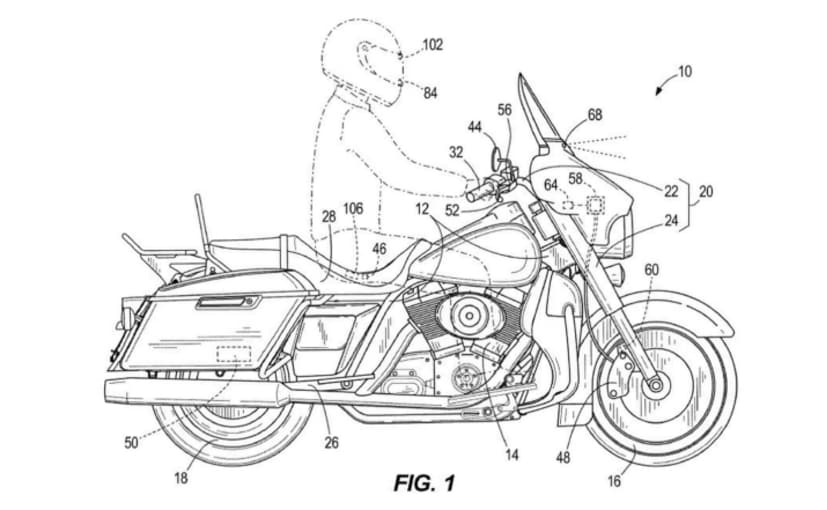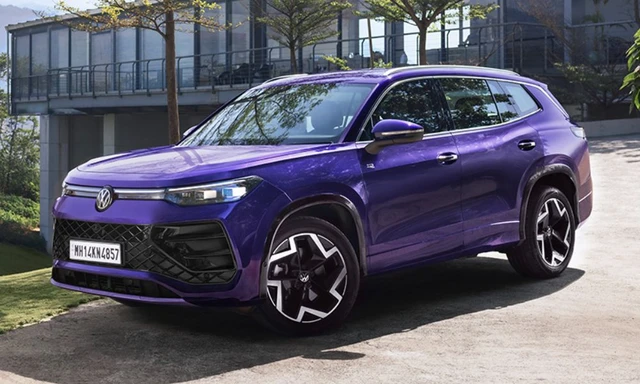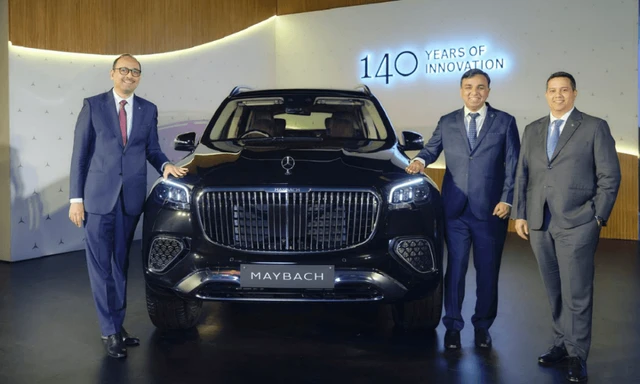Harley-Davidson Patents Showcase Emergency Automated Braking System

- Harley-Davidson may be working on its own adaptive braking system
- The system is different from adaptive cruise control
- The system may be eventually used in future Harley-Davidson models
Harley-Davidson may be working on its latest range of electronic rider aids, with latest patent filings showing a kind of emergency automated braking system. The system is not similar to adaptive cruise control that many other manufacturers have already showcased. But Harley-Davidson's system is described more as a crash avoidance system, which will be called upon only in times of emergency. An array of sensors are part of the system, and these sensors can also be used as part of an adaptive cruise control system. The idea is that these sensors monitor the bike's surroundings and also the rider.
Also Read: Harley-Davidson Patents Supercharged V-Twin Engine

The patent images show warning lights, and even a dash-mounted camera which will monitor the rider's line of vision
The system uses sensors on the handlebar grips, the seat and also has a camera mounted on the dash that looks back at the rider. Before the system begins to take any sort of action, a series of warning lights and haptic and audible warnings will alert the rider to react and take action. If the rider does not respond, the system will begin applying the bike's brakes. The system is apparently also designed to see how much braking power should be applied, so it can theoretically even add some braking force if it senses that the rider is not applying enough pressure on the brakes.
Also Read: Harley-Davidson Pan America India Launch Details Revealed
The new patent filings also mention the use of a helmet-mounted camera that is aimed at the rider's eye. The camera will use vision-tracking technology which will determine not only of the rider's eye is open, but also judge in what direction the rider is looking at, ensuring that the focus is on the road. Presumably, some sort of warning lights and haptic feedback will be given if the rider is seen to be not responding or if his vision is not focussed on the road.
Latest News
 Jaiveer Mehra | Jan 15, 2026Volvo EX60 SUV Global Debut On Jan 21; Will Offer 810 km RangeNew GLC EV rival will be the first Volvo to use the next-gen SPA3 platform and support 400 kW fast charging.1 min read
Jaiveer Mehra | Jan 15, 2026Volvo EX60 SUV Global Debut On Jan 21; Will Offer 810 km RangeNew GLC EV rival will be the first Volvo to use the next-gen SPA3 platform and support 400 kW fast charging.1 min read Jaiveer Mehra | Jan 15, 2026India-Spec Volkswagen Tayron RevealedThree-row SUV will be offered in the R-Line trim with features like 19-inch wheels, a 15-inch touchscreen, front seats with ventilation & massage function and more.1 min read
Jaiveer Mehra | Jan 15, 2026India-Spec Volkswagen Tayron RevealedThree-row SUV will be offered in the R-Line trim with features like 19-inch wheels, a 15-inch touchscreen, front seats with ventilation & massage function and more.1 min read car&bike Team | Jan 15, 2026Mercedes-Benz EQS SUV Gets A Celebration Edition For 2026, Prices start at Rs. 1.34 CroreThe new celebration edition will be available with both the EQS 450 and the EQS 580 versions of the SUV.1 min read
car&bike Team | Jan 15, 2026Mercedes-Benz EQS SUV Gets A Celebration Edition For 2026, Prices start at Rs. 1.34 CroreThe new celebration edition will be available with both the EQS 450 and the EQS 580 versions of the SUV.1 min read Jaiveer Mehra | Jan 15, 2026Auto Sales: Mercedes-Benz Sales Decline 3 Per Cent; 19,007 Units Sold In CY2025The German carmaker reported year-on-year growth in sales for its Top-End Vehicles (TEVs), EV range, and AMG models, although sales in entry-level segments were down 20 per cent.3 mins read
Jaiveer Mehra | Jan 15, 2026Auto Sales: Mercedes-Benz Sales Decline 3 Per Cent; 19,007 Units Sold In CY2025The German carmaker reported year-on-year growth in sales for its Top-End Vehicles (TEVs), EV range, and AMG models, although sales in entry-level segments were down 20 per cent.3 mins read Jaiveer Mehra | Jan 14, 2026Bajaj Chetak C25 Launched In India; Prices Start From Rs 91,399The new series is the most affordable under the Chetak family and gets a hub-mounted electric motor - a first for the Chetak family.2 mins read
Jaiveer Mehra | Jan 14, 2026Bajaj Chetak C25 Launched In India; Prices Start From Rs 91,399The new series is the most affordable under the Chetak family and gets a hub-mounted electric motor - a first for the Chetak family.2 mins read car&bike Team | Jan 14, 2026India-Made Mercedes-Maybach GLS Launched At Rs 2.75 CroreThe locally assembled Maybach GLS is Rs 42 lakh cheaper than the imported model.1 min read
car&bike Team | Jan 14, 2026India-Made Mercedes-Maybach GLS Launched At Rs 2.75 CroreThe locally assembled Maybach GLS is Rs 42 lakh cheaper than the imported model.1 min read
 Bilal Firfiray | Jan 9, 2026Toyota Urban Cruiser Hyryder: 10,000 km Long-Term ReviewAfter spending over three months and 10,000 km with the Toyota Urban Cruiser Hyryder Hybrid, we were impressed by its real-world mileage, seamless hybrid, practical comfort, and Toyota reliability. Is it the best C-SUV then?5 mins read
Bilal Firfiray | Jan 9, 2026Toyota Urban Cruiser Hyryder: 10,000 km Long-Term ReviewAfter spending over three months and 10,000 km with the Toyota Urban Cruiser Hyryder Hybrid, we were impressed by its real-world mileage, seamless hybrid, practical comfort, and Toyota reliability. Is it the best C-SUV then?5 mins read Seshan Vijayraghvan | Jan 8, 20262026 Mahindra XUV 7XO Review: Big On Tech, Bigger On ComfortThe new Mahindra XUV 7XO is flashier, feature packed, and comes with more advanced tech. But are the changes just incremental or actually substantial?1 min read
Seshan Vijayraghvan | Jan 8, 20262026 Mahindra XUV 7XO Review: Big On Tech, Bigger On ComfortThe new Mahindra XUV 7XO is flashier, feature packed, and comes with more advanced tech. But are the changes just incremental or actually substantial?1 min read Preetam Bora | Jan 10, 2026Simple One Gen 2 First Ride Review: 265 km Claimed Range!The Gen 2 model of Simple Energy’s first electric scooter gets a fair few updates, including new features, tech, more range and lighter weight. We spent a couple of hours with the Simple One Gen 2 to find out if it manages to impress.6 mins read
Preetam Bora | Jan 10, 2026Simple One Gen 2 First Ride Review: 265 km Claimed Range!The Gen 2 model of Simple Energy’s first electric scooter gets a fair few updates, including new features, tech, more range and lighter weight. We spent a couple of hours with the Simple One Gen 2 to find out if it manages to impress.6 mins read Amaan Ahmed | Jan 3, 2026VLF Mobster 135 300 KM Review: Fun But FlawedA 125 cc scooter with Italian design and Chinese genes is a rare combination, and while some may be tempted to dismiss it because of its origins, the VLF Mobster shows 125s can also be exciting – but not without compromises.11 mins read
Amaan Ahmed | Jan 3, 2026VLF Mobster 135 300 KM Review: Fun But FlawedA 125 cc scooter with Italian design and Chinese genes is a rare combination, and while some may be tempted to dismiss it because of its origins, the VLF Mobster shows 125s can also be exciting – but not without compromises.11 mins read Preetam Bora | Dec 30, 2025TVS Orbiter Review: Real-World Performance and Range TestedThe TVS Orbiter is a promising electric scooter promising decent range, practicality and pricing. But is there any reason to avoid it? We spent a few days getting to know it better.9 mins read
Preetam Bora | Dec 30, 2025TVS Orbiter Review: Real-World Performance and Range TestedThe TVS Orbiter is a promising electric scooter promising decent range, practicality and pricing. But is there any reason to avoid it? We spent a few days getting to know it better.9 mins read




































































































































